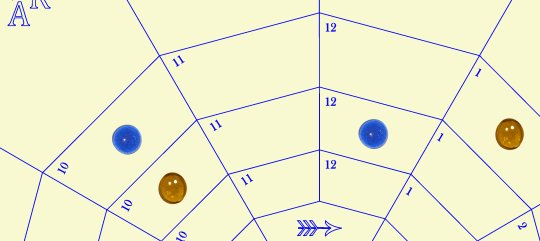Ricochet
Aranea Ricochet is a variation which adds a little more complexity.
When a player initially places a stone (the placement stone) from their pool of stones onto the outermost ring on an occupied square, the existing stone (the richochet stone) is bumped clockwise regardless of whose stone it is. The ricochet movement goes clockwise until it encounters another stone (the displaced stone) in that same ring. The displaced stone behaves as if it were landed on by the original placement stone - if it is the current players stone, it moves inward to the next ring according to regular Aranea rules. If it is the opponents stone, it is removed from the board. The ricochet stone occupies the original position of the displaced stone regardless of who owns the ricochet stone. If there are no other stones in the current ring, the ricochet stone makes a complete circuit and displaces the original placement stone.
(Aranea Rules have an alternative mode of play called Clash mode. In this mode, the player going first makes moves on the ring in a clockwise direction as normal but the player going second makes ring moves in a counter-clockwise direction. You may also play the Ricochet variation in Clash mode. In this mode, the ricochet stone moves clockwise as normal for the player going first but the ricochet stone moves counter-clockwise for the player going second.)
|
|
|
Before the move. |
|
|
|
Amber rolls a 10, places a stone on the outer ring. The blue stone that was on 10 ricochets clockwise until it encounters the amber stone on the one. This is Amber's play so the amber stone on the one moves to the next ring. The blue ricochet stone assumes the one square on the outer ring. Had the stone on one been a blue stone, amber's play would have removed it from the board. The color of the ricochet stone doesn't matter, only the color of the original placement stone on the 10 and the displaced stone on the one. |

